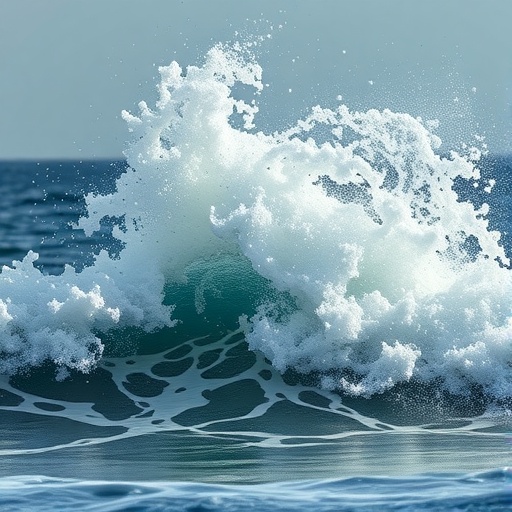The emergence of order and collective behavior in complex living systems is a profound mystery that intertwines physics, biology, and chemistry. At the heart of this phenomenon lies a fundamental mechanism—non-reciprocal interactions—that offers a fresh perspective on how stable, large-scale collective motions can arise spontaneously in active matter. Researchers at the Max Planck Institute for Dynamics and Self-Organization (MPI-DS), specifically the Department of Living Matter Physics, have unveiled groundbreaking insights into the role of these asymmetric interactions in fostering robust, self-sustained patterns even under challenging environmental conditions.
Non-reciprocal interactions differ from traditional reciprocal forces by their directional asymmetry: one species or particle exerts an attractive influence on another species, which, conversely, experiences a repulsive interaction back. Such non-mutual influences can generate dynamic patterns of movement where one species persistently chases or orients toward another, leading to emergent spatiotemporal structures. This interaction motif is analogous to scenarios ranging from chemical oscillations to predator-prey dynamics, but its physical underpinnings and implications on collective scales are only now coming to light.
The MPI-DS team, led by scientists including Giulia Pisegna and Suropriya Saha, utilized sophisticated computational modeling and simulations to probe the behavior of two interacting species subject to non-reciprocal forces. Their studies revealed that these asymmetric couplings can instigate spontaneous collective motion—a process where individual particles synchronize directionally to form a coherent, migrating assembly. Unlike many active systems which devolve into disorder or finite clusters, non-reciprocal mixtures demonstrated strikingly stable and ordered motile phases emerging across the entire system.
Importantly, this collective chase is not fragile. The team subjected their computational models to extensive perturbations, including stochastic noise mimicking random fluctuations common in natural environments. Contrary to expectations that noise might dissipate any emerging order, the non-reciprocal dynamics exhibited remarkable resilience. The resulting collective motion persisted stably, highlighting that such interaction schemes could underpin robust self-organization even when confronted with significant external disturbances.
Diving deeper, the researchers integrated hydrodynamic interactions into their framework by placing the particles within viscous fluids, a common scenario in biological or chemical suspensions. Typically, fluid-mediated interactions can introduce long-range couplings and complex flow fields that destabilize collective migration. Yet, non-reciprocal interactions retained their stabilizing influence, allowing large-scale collective motion to endure despite the hydrodynamic coupling. This finding is significant because it suggests real-world systems, from microbial communities to synthetic active colloids, might exploit non-reciprocity to maintain order in fluidic environments.
The conceptual breakthrough of this study lies in bridging seemingly unrelated theoretical domains. By linking flocking theories—governing coordinated motion in animal groups—with surface growth dynamics, traditionally used in materials science, the authors formulated a unifying framework describing non-reciprocal mixtures. This multidisciplinary approach allowed them to derive predictive scaling laws and understand how local chasing interactions propagate to system-wide patterns, shedding light on the emergence of persistent collective motion.
From a biological perspective, non-reciprocal interactions may represent a primitive mechanism for self-organization, playing a fundamental role in the development of early life and complex chemical environments. The chasing dynamics intrinsic to non-reciprocity could underlie processes ranging from cellular signaling to ecological population dynamics, where the coordination of multiple species or molecules is essential for function and stability. Understanding these principles expands our capacity to design artificial active materials and synthetic biological systems that mimic life-like behaviors.
Furthermore, the robustness of non-reciprocal motility patterns indicates that living and synthetic matter designed with asymmetric interactions might be more adaptable to environmental variability. This resilience under external noise and fluid coupling adds a crucial piece to the puzzle of how living systems maintain homeostasis and functionality in fluctuating conditions. It also raises intriguing possibilities for engineering microscale robots or particles that self-organize and navigate complex environments autonomously.
The MPI-DS findings provoke a reconsideration of how we model interactions in active matter. Traditional models often rely on reciprocal, symmetric forces or simplistic alignment rules. Introducing non-reciprocal terms enriches the diversity of emergent behaviors and provides a more faithful representation of real-world systems where asymmetry is abundant. This paradigm shift challenges researchers to re-examine experimental observations in microbiology, chemistry, and physics through the lens of directional interaction heterogeneity.
One particularly striking aspect of non-reciprocal systems is their ability to sustain spatiotemporal patterns without external orchestration. The persistent chasing and resulting pattern formation are self-organized phenomena emerging from the intrinsic dynamics of the mixture components. Such self-organization principles align with one of the grand challenges in physics and biology: understanding how complexity arises naturally, avoiding the pitfalls of randomness or chaos to achieve functional order.
Looking forward, this research paves the way for experimental validation using active colloids, synthetic chemical mixtures, or microbial consortia designed with engineered interaction asymmetries. The predictive models established here offer testable hypotheses and quantitative metrics for assessing the stability and dynamical features of collective motion induced by non-reciprocal interactions. Achieving experimental realization will catalyze applications in materials science, biomedical engineering, and ecological management.
In sum, the pioneering work on non-reciprocal mixtures elucidates a novel class of active matter phenomena where directionally asymmetric interactions serve as the underlying engine for persistent collective motion. The discovery that such dynamics remain stable amidst noise and hydrodynamic complexity elevates non-reciprocity to a fundamental organizing principle in living and synthetic systems. This insight opens exciting avenues to harness these mechanisms for controlling self-assembly, pattern formation, and functional behavior in a wide array of scientific fields, ultimately deepening our understanding of the physics of life.
Subject of Research: Not applicable
Article Title: Nonreciprocal Mixtures in Suspension: The Role of Hydrodynamic Interactions
News Publication Date: 3-Sep-2025
Web References:
DOI Link
Image Credits: © MPI-DS, LMP
Keywords: non-reciprocal interactions, active matter, collective motion, self-organization, hydrodynamics, spatiotemporal patterns, computational modeling, living matter physics, stability, asymmetric interactions




